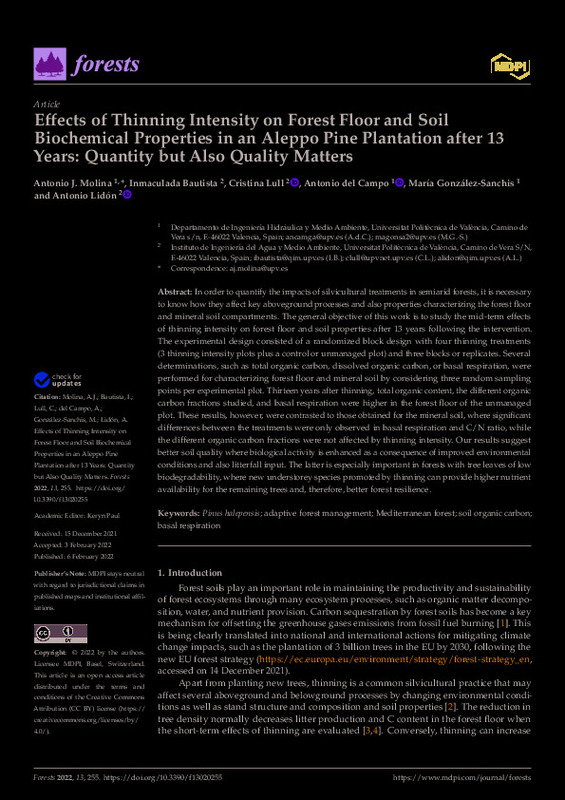JavaScript is disabled for your browser. Some features of this site may not work without it.
Buscar en RiuNet
Listar
Mi cuenta
Estadísticas
Ayuda RiuNet
Admin. UPV
Effects of Thinning Intensity on Forest Floor and Soil Biochemical Properties in an Aleppo Pine Plantation after 13 Years: Quantity but Also Quality Matters
Mostrar el registro sencillo del ítem
Ficheros en el ítem
| dc.contributor.author | Molina, Antonio J.
|
es_ES |
| dc.contributor.author | Bautista, Inmaculada
|
es_ES |
| dc.contributor.author | Lull, Cristina
|
es_ES |
| dc.contributor.author | Campo García, Antonio Dámaso Del
|
es_ES |
| dc.contributor.author | González Sanchis, María del Carmen
|
es_ES |
| dc.contributor.author | Lidón, Antonio
|
es_ES |
| dc.date.accessioned | 2022-12-22T19:00:31Z | |
| dc.date.available | 2022-12-22T19:00:31Z | |
| dc.date.issued | 2022-02-03 | es_ES |
| dc.identifier.uri | http://hdl.handle.net/10251/190906 | |
| dc.description.abstract | [EN] In order to quantify the impacts of silvicultural treatments in semiarid forests, it is necessary to know how they affect key aboveground processes and also properties characterizing the forest floor and mineral soil compartments. The general objective of this work is to study the mid-term effects of thinning intensity on forest floor and soil properties after 13 years following the intervention. The experimental design consisted of a randomized block design with four thinning treatments (3 thinning intensity plots plus a control or unmanaged plot) and three blocks or replicates. Several determinations, such as total organic carbon, dissolved organic carbon, or basal respiration, were performed for characterizing forest floor and mineral soil by considering three random sampling points per experimental plot. Thirteen years after thinning, total organic content, the different organic carbon fractions studied, and basal respiration were higher in the forest floor of the unmanaged plot. These results, however, were contrasted to those obtained for the mineral soil, where significant differences between the treatments were only observed in basal respiration and C/N ratio, while the different organic carbon fractions were not affected by thinning intensity. Our results suggest better soil quality where biological activity is enhanced as a consequence of improved environmental conditions and also litterfall input. The latter is especially important in forests with tree leaves of low biodegradability, where new understorey species promoted by thinning can provide higher nutrient availability for the remaining trees and, therefore, better forest resilience. | es_ES |
| dc.description.sponsorship | A.J. Molina is the beneficiary of an "APOSTD' fellowship (APOSTD/2019/111) funded by the Generalitat Valenciana. The authors received national and international funding through the following projects: SILVADAPT.NET (RED2018-102719-T funded by MCIN/AEI/10.13039/501100011033), CEHYRFO-MED (CGL2017-86839-C3-2-R funded by MCIN/AEI/10.13039/501100011033 and FEDER a way to make Europe), and RESILIENTFORESTS (LIFE17 CCA/ES/000063) | es_ES |
| dc.language | Inglés | es_ES |
| dc.publisher | MDPI AG | es_ES |
| dc.relation.ispartof | Forests | es_ES |
| dc.rights | Reconocimiento (by) | es_ES |
| dc.subject | Pinus halepensis | es_ES |
| dc.subject | Adaptive forest management | es_ES |
| dc.subject | Mediterranean forest | es_ES |
| dc.subject | Soil organic carbon | es_ES |
| dc.subject | Basal respiration | es_ES |
| dc.subject.classification | INGENIERIA HIDRAULICA | es_ES |
| dc.subject.classification | EDAFOLOGIA Y QUIMICA AGRICOLA | es_ES |
| dc.subject.classification | TECNOLOGIA DEL MEDIO AMBIENTE | es_ES |
| dc.title | Effects of Thinning Intensity on Forest Floor and Soil Biochemical Properties in an Aleppo Pine Plantation after 13 Years: Quantity but Also Quality Matters | es_ES |
| dc.type | Artículo | es_ES |
| dc.identifier.doi | 10.3390/f13020255 | es_ES |
| dc.relation.projectID | info:eu-repo/grantAgreement/AEI/Plan Estatal de Investigación Científica y Técnica y de Innovación 2013-2016/CGL2017-86839-C3-2-R/ES/INCORPORACION DE CRITERIOS ECO-HIDROLOGICOS Y DE RESILIENCIA FRENTE A PERTURBACIONES CLIMATICAS Y DEL FUEGO EN LA PLANIFICACION Y GESTION FORESTAL DE CUENCAS MEDITERRANEAS/ | es_ES |
| dc.relation.projectID | info:eu-repo/grantAgreement/AEI//RED2018-102719-T//RED ESPAÑOLA DE SELVICULTURA ADAPTATIVA AL CAMBIO CLIMATICO/ | es_ES |
| dc.relation.projectID | info:eu-repo/grantAgreement/COMISION DE LAS COMUNIDADES EUROPEA//LIFE17 CCA%2FES%2F000063//Coupling water, fire and climate resilience with biomass production in Forestry to adapt watersheds to climate change/ | es_ES |
| dc.rights.accessRights | Abierto | es_ES |
| dc.contributor.affiliation | Universitat Politècnica de València. Escuela Politécnica Superior de Gandia - Escola Politècnica Superior de Gandia | es_ES |
| dc.contributor.affiliation | Universitat Politècnica de València. Escuela Técnica Superior de Ingeniería Agronómica y del Medio Natural - Escola Tècnica Superior d'Enginyeria Agronòmica i del Medi Natural | es_ES |
| dc.description.bibliographicCitation | Molina, AJ.; Bautista, I.; Lull, C.; Campo García, ADD.; González Sanchis, MDC.; Lidón, A. (2022). Effects of Thinning Intensity on Forest Floor and Soil Biochemical Properties in an Aleppo Pine Plantation after 13 Years: Quantity but Also Quality Matters. Forests. 13(2):1-14. https://doi.org/10.3390/f13020255 | es_ES |
| dc.description.accrualMethod | S | es_ES |
| dc.relation.publisherversion | https://doi.org/10.3390/f13020255 | es_ES |
| dc.description.upvformatpinicio | 1 | es_ES |
| dc.description.upvformatpfin | 14 | es_ES |
| dc.type.version | info:eu-repo/semantics/publishedVersion | es_ES |
| dc.description.volume | 13 | es_ES |
| dc.description.issue | 2 | es_ES |
| dc.identifier.eissn | 1999-4907 | es_ES |
| dc.relation.pasarela | S\455919 | es_ES |
| dc.contributor.funder | GENERALITAT VALENCIANA | es_ES |
| dc.contributor.funder | AGENCIA ESTATAL DE INVESTIGACION | es_ES |
| dc.contributor.funder | COMISION DE LAS COMUNIDADES EUROPEA | es_ES |
| dc.subject.ods | 15.- Proteger, restaurar y promover la utilización sostenible de los ecosistemas terrestres, gestionar de manera sostenible los bosques, combatir la desertificación y detener y revertir la degradación de la tierra, y frenar la pérdida de diversidad biológica | es_ES |
| upv.costeAPC | 1136,16 | es_ES |








